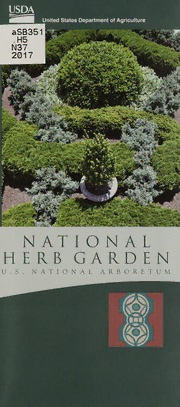
National herb garden, U.S. National Arboretum PDF
Preview National herb garden, U.S. National Arboretum
Historic, Archive Document Do not assume content reflects current scientific knowledge, policies, or practices. sare ul an mic ov aa e tt " «aAy WrT o7 aewo ‘ i = N}A United States Department of Agriculture NAlI1ON Al ARBOetR U M Mention herbs and most people think of basil and rosemary or other savory plants used in cooking. They may not realize that henna (used for dye) and pine (used for turpentine) are also examples of herbs. The 2 Y%-acre National Herb Garden exhibits thousands of plants like these that illustrate the definition of an herb as any plant that enhances people’s lives. Many herbs support our everyday activities: We dress in cotton clothing, brush our teeth with mint- flavored toothpaste, and clean our furniture with citrus oil polish. The collections of the National Herb Garden demonstrate the indispensable role herbal plants play in our world. Detail of cotton, Gossypium hirsutum cv. ENTRANCE GARDEN A wide variety of herbal plants greet visitors in the beds encircling the pool and fountain in the Entrance Garden. This introduction to the world of herbs includes trees, shrubs, perennials, bulbs, and annuals. Many containers hold examples of tropical species, such as cinnamon, which do not grow in the Mid-Atlantic climate and must overwinter in the greenhouse. Each year, portions of the beds feature special seasonal displays, such as the herb of the year or plants that release scents when touched. The higher elevation of this garden permits views of the Knot Garden below and of the nearby National Capitol Columns. Companion plants like | larkspur and lilies | accent the Heritage — Rose Garden. eee. KNOT GARDEN Knot gardens reflect Old World taste for formal design and bountiful plantings of herbs. In Medieval times, gardeners devoted hours to pruning and clipping the herbs in such gardens to keep them tidy. Today, with a wealth of herbal plants available, knot gardens can be less labor intensive. The National Herb Garden’s knot garden uses low-maintenance dwarf varieties of holly, false cypress, and arborvitae to create the interlocking pattern. These evergreen shrubs are all herbs, because their resins, leaves, or fruits are used for medicinal purposes or as fragrances. HERITAGE ROSE GARDE The large area dedicated to roses in the National Herb Garden symbolizes the widespread importance of this familiar flower throughout history. The rose’s alluring fragrance and concentrated vitamin content has assured its value to people of many cultures. The Roman naturalist and philosopher Pliny the Elder recorded more than a dozen ailments for which rose preparations were effective treatments. In many Asian countries, the rose has been a flavoring for centuries. The roses in this collection represent both the rich diversity of varieties grown before 1930 and the genetic heritage of all modern roses. Pee GARD THEME GARDENS Animated discussions occur frequently in this collection of herbs. Visitors may recognize a plant that a grandparent grew or a plant from a childhood backyard in another country. Distinctive theme gardens offer opportunities for learning about hundreds of herbs in 10 categories: Asian, Beverage, Colonial, Culinary, Dioscorides (first-century A.D. author of the earliest known encyclopedia of medicinal herbs), Dye, Fragrance, Industrial, Medicinal, and Native American. Detailed labels identify the plants and explain their uses, helping visitors to make connections with the botanical companions that have served people throughout history. Rosa 'Cramoisi Superieur' | isatype of Chinarose _ introduced in France in 1932. N NATIONAL HERB GARDEN wines s aan ie Ra eet eat ae eee Bain cf hSaik eRnetcoa.h eh Veno H, gon MAP KEY A} ENTRANCE GARDEN B| KNOT GARDEN C}| HERITAGE ROSE GARDEN DE THEME GARDENS BiEe AUEvRa nPteangte ? inhi 7G cog betes Se nF RANE HARE ih ows Tyg yet neaaet ta? *‘ ono ao e PSEA Ae geaaeyuAa Ie AC oNys. eoS Pnav e iege ey lege NORTH MOR S 8:00 a.m. to 5:00 p.m. daily Closed December 25 Pe ntEN EITIQUEITE Bicycles are not permitted in the garden. Please supervise children at all times. The National Herb Garden showcases plants that enhance people’s lives as flavorings, fragrances, medicines, coloring agents, and additives in industrial products. The garden exhibits these herbal plants from places and cultures around the world in theme gardens, single-genus collections, and seasonal displays for education, research, and aesthetic enjoyment. jateenetorlacetssteet for the National Herb Garden is provided by the Herb Society of America. For information about the Society, visTit www.heirbsociet y.org. U. S. NATIONAL ARBORETUM 3501 New York Avenue, NE Washington, DC 20002 202-245-2726 www.usna.usda.gov UNITED STATES DEPARTMENT OF AGRICULTURE AGRICULTURAL RESEARCH SERVICE USDA is an equal opportunity provider, employer, and lender. Program Aid No. 2119 : September 2012, Slightly Revised October 2017
